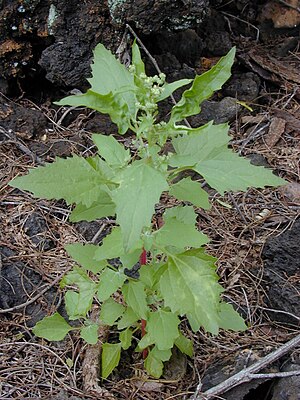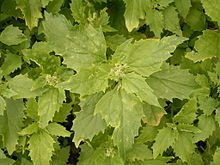Wall goosefoot
| Wall goosefoot | ||||||||||||
|---|---|---|---|---|---|---|---|---|---|---|---|---|

Wall goosefoot ( Chenopodiastrum murale ) |
||||||||||||
| Systematics | ||||||||||||
|
||||||||||||
| Scientific name | ||||||||||||
| Chenopodiastrum murale | ||||||||||||
| ( L. ) S. Fuentes , Uotila & Borsch |
The wall goose foot ( Chenopodiastrum murale , Syn .: Chenopodium murale ) is a species of plant in the foxtail family (Amaranthaceae). It is native to Europe, North Africa and Southwest Asia and is now found almost worldwide.
description
Vegetative characteristics
The wall goose foot is an annual herbaceous plant with heights of growth of usually 10 to 70 (up to 120) cm. The upright stalk is yellowish to green-striped, rarely a little reddish, glabrous or at most slightly floury when young. It is especially branched out at the base, the lowest branches are almost opposite.
The mostly olive-green, sometimes yellowish or reddish leaves are thin or somewhat fleshy, not aromatic, shiny on top, sometimes indistinctly floury when young. The petiole is 1 to 2.5 cm long. The leaf blade is triangular, ovate or rhombic-ovate with a length of 1 to 8 (to 10) cm and a width of 0.4 to 3 (to 5) cm. The leaf base can narrow in a wedge shape into the petiole or be truncated or rounded. The leaf margin is roughly irregularly cupped to sharply serrated or serrated, with mostly forward-facing teeth. The uppermost leaves are lanceolate and sometimes almost entire.
Inflorescence and flower
The terminal or axillary inflorescences are shorter than the bract . They consist of densely arranged, globular, almost spherical partial inflorescences with a diameter of 2 to 4 mm. Individual flowers can also appear outside of clusters. There are no front pages. The hermaphroditic or sometimes all-female flowers have an envelope of five green, floured tepals that are only connected in the lower part . The Tepalenzipfel are egg-shaped, up to 0.8 mm long and up to 0.7 mm wide, clearly keeled on the back, especially in the upper part. There are five stamens . On the ovary has two scars.
Fruit and seeds
At the time of fruiting, the fruit remains enclosed by the green, sometimes red-turning flower envelope and falls off together with it. The fruit is flat-egg-shaped, the distinctly papillary pericarp lies close to the seed and becomes smooth when the fruit is ripe. The horizontal seed measures 1 to 1.5 mm in diameter and is lens-shaped with a round outline and sharply keeled on the edge. The black seed coat is densely covered with very small, unextended pits.
Flower ecology
The flowering period extends from July to September. Pollination is usually done by the wind.
Chromosome number
The number of chromosomes is 2n = 18.
ecology
The wall goose foot is a food plant for the caterpillars of the palm moth Scrobipalpa atriplicella .
A downy mildew ( Peronospora farinosa ), lives parasitically on the nettle-leaved goosefoot.
Occurrence and endangerment
The natural range of the wall goose foot stretches from the Canary Islands and Madeira across North Africa and Central and South Europe to Southwest and South Asia. As an introduced species, it occurs almost worldwide, especially in subtropical and warm-temperate regions, and is one of the most widespread species of the genus.
The wall goose foot belongs to the ruderal vegetation on roadsides and roadsides, railway lines, or village weed fields. It is widespread from the plain to the hill level ( altitude levels ). In Pakistan it reaches altitudes of up to 1675 meters, in North America it was found at altitudes of up to 2000 meters.
In Germany , the wall goose foot is an archaeophyte or was possibly indigenous without human intervention. Here it grows scattered in short-lived weed meadows, especially in dry and warm areas, where it populates nutrient-rich places in village settlements, roadsides, house walls or chicken yards. It thrives on moderately dry, nutrient-rich, ammoniacal, mild, humus-rich soils. In Central Europe it is a character type of the Sisymbrion association. In southern and western Europe it is a character species of the Chenopodietum muralis from the association Chenopodion muralis.
The wall goose foot in Germany is endangered nationwide ( Red List of Endangered Species 3+) due to village renovation, castle restoration, wall jointing and the destruction of these special locations. In Brandenburg and Rhineland-Palatinate it is considered endangered, in Mecklenburg-Western Pomerania , Saxony , Thuringia , Hesse and Bavaria as severely endangered. It is already threatened with extinction in Lower Saxony , Saxony-Anhalt , North Rhine-Westphalia , Baden-Württemberg and Berlin . It is considered extinct in Schleswig-Holstein and Hamburg .
In Switzerland , too , the Wall Goose foot is considered endangered or threatened with extinction in several areas.
Systematics
The first publication of Basionyms Chenopodium murale L. was carried out in 1753 by Carl Linnaeus in Species Plantarum . Molecular genetic studies showed that the species does not belong to the goosefoot in the narrower sense. Therefore it was placed in 2012 by Suzy Fuentes-Bazan , Pertti Uotila and Thomas Borsch as Chenopodiastrum murale (L.) S. Fuentes, Uotila & Borsch in the newly described genus Chenopodiastrum in the Atripliceae tribe .
Further synonyms that are based on the same type specimen are Anserina muralis (L.) Montandon and Atriplex muralis (L.) Crantz . Other synonyms are Chenopodium biforme Nees , Chenopodium carthagenense Zuccagni , Chenopodium chamrium Buch.-Ham. (nom. invalid.), Chenopodium congestum Hook.f. , Chenopodium flavum Forssk. , Chenopodium gandhium Buch.-Ham. (nom. invalid.), Chenopodium guineense Jacq. , Chenopodium laterale Aiton , Chenopodium longidjawense Peter , Chenopodium lucidum Gilib. , Chenopodium maroccanum Pau , Rhagodia baccata var. Congesta (Hook.f.) Hook.f. , Rhagodia billardierei R.Br. , Rhagodia congesta (Hook.f.) Moq. and Vulvaria trachisperma Bubani .
use
The leaves and young shoots of the wall goose foot can be cooked raw or cooked like spinach. Raw leaves should because of their content of saponins are, however, consumed only in small quantities. The seeds are also edible when cooked. It is recommended that you soak them overnight and then rinse them thoroughly to remove the saponins. The seeds can also be used as flour additive when ground.
The whole plant can be used as a coloring plant for golden-green shades.
supporting documents
literature
- Henning Haeupler, Thomas Muer: picture atlas of the fern and flowering plants of Germany . Ed .: Federal Agency for Nature Conservation (= The fern and flowering plants of Germany . Volume 2 ). Eugen Ulmer, Stuttgart (Hohenheim) 2000, ISBN 3-8001-3364-4 , pp. 89 (sections description, occurrence).
- Steven E. Clemants, Sergei L. Mosyakin: Chenopodium. In: Flora of North America Editorial Committee (Ed.): Flora of North America North of Mexico . Volume 4: Magnoliophyta: Caryophyllidae, part 1 . Oxford University Press, New York / Oxford a. a. 2003, ISBN 0-19-517389-9 , Chenopodium murale , pp. 287 (English, online ). (Sections Description, Occurrence)
- Pertti Uotila: Chenopodium : In: Helmut Freitag, Ian C. Hedge, Saiyad Masudal Hasan Jafri, Gabriele Kothe-Heinrich, S. Omer, Pertti Uotila: Flora of Pakistan 204: Chenopodiaceae. University of Karachi, Department of Botany / Missouri Botanical Garden Press, Karachi / St. Louis 2001, Chenopodium murale (online) . (Sections Description, Occurrence).
Individual evidence
- ↑ a b Susy Fuentes-Bazan, Pertti Uotila, Thomas Borsch: A novel phylogeny-based generic classification for Chenopodium sensu lato, and a tribal rearrangement of Chenopodioideae (Chenopodiaceae). In: Willdenowia. Volume 42, No. 1, 2012, pp. 5–24, here: p. 14. DOI: 10.3372 / wi.42.42101
- ↑ Chenopodium murale atBiolFlor - database of biological-ecological characteristics of the flora of Germany.
- ↑ a b c Chenopodium murale at Tropicos.org. Missouri Botanical Garden, St. Louis, accessed January 30, 2012.
- ↑ Gaden S. Robinson, Phillip R. Ackery, Ian J. Kitching, George W. Beccaloni, Luis M. Hernández: Entry at HOSTS - A Database of the World's Lepidopteran Hostplants , accessed on January 31, 2012.
- ↑ Entry in EOL , accessed January 30, 2012.
- ↑ Chenopodiastrum murale in the Germplasm Resources Information Network (GRIN), USDA , ARS , National Genetic Resources Program. National Germplasm Resources Laboratory, Beltsville, Maryland. Retrieved July 3, 2013.
- ↑ a b Wall goosefoot. In: FloraWeb.de.
- ↑ a b c d Erich Oberdorfer : Plant-sociological excursion flora for Germany and neighboring areas . With the collaboration of Angelika Schwabe and Theo Müller. 8th, heavily revised and expanded edition. Eugen Ulmer, Stuttgart (Hohenheim) 2001, ISBN 3-8001-3131-5 , pp. 344 .
- ↑ Chenopodium murale. In: Info Flora (the national data and information center for the Swiss flora) , accessed on January 31, 2012.
- ↑ Carl von Linné: Species Plantarum. Volume 1, Lars Salvius, Stockholm 1753, p. 219, digitized .
- ^ Entry in The Plant List , accessed January 30, 2012.
- ↑ a b Chenopodium murale at Plants For A Future . Retrieved January 31, 2012.
Web links
- Wall goosefoot. In: FloraWeb.de.
- Distribution map for Germany. In: Floraweb .
- Chenopodium murale L. In: Info Flora , the national data and information center for Swiss flora .
- Distribution in the northern hemisphere from: Eric Hultén, Magnus Fries: Atlas of North European vascular plants. 1986, ISBN 3-87429-263-0 at Den virtuella floran (swed.)
- Thomas Meyer: Data sheet with identification key and photos at Flora-de: Flora von Deutschland (old name of the website: Flowers in Swabia )
- Günter Blaich: Photos of European plants : Chenopodium murale .





